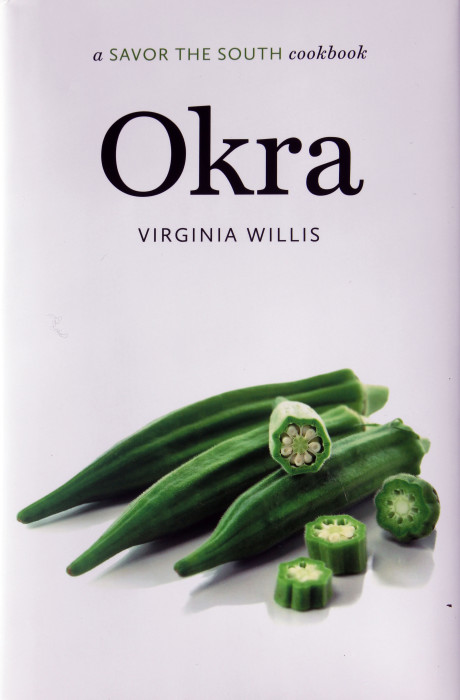When it comes to okra, author Virginia Willis understands folks divide into “love it” or “leave it” groups. Growing up in Louisiana where okra was in nearly every gumbo, Virginia believes the “leave it” folks deserve a second chance. And even a second helping.
Virginia has written Okra, the latest is the lovely and lively series Savor the South Cookbooks from the University of North Carolina Press. [If you are not familiar with the series, you want to be. You can easily learn more by going to Amazon and just searching on Savor the South.]
Time to look up at okra. Literally up. Because some species can be ten feet tall and adorned with flowers that, well, remind you of hibiscus or hollyhocks. Beautiful to behold and for a reason. Okra is related to both those plants.
That’s part of the wealth of information Virginia offers you in Okra. She wants this book to be a one-stop shopping venue for everything about okra: history, plant specifics, and varieties both heirloom and hybrid, planting and growing tips, and of course recipes galore.
We know okra originated near the equator in Africa, migrated to the Mediterranean and India, then came to the New World via the slave trade. The American South offers a climate and soil that lets the plant thrive. Outside the South in the US, well, okra is a bit misunderstood and misused. Farmers grow it too big, chefs wrestle with some cooking nuances — ones Virginia readily deals with in Okra.
When you have wandered through all the recipes, I believe you will understand why, in the American South, not just homes but high-end restaurants embrace okra. And, when you read the recipes from around the rest of the world, you gain a sense of excitement about what intriguing dishes can spotlight this gargantuan plant.
Recipes in Okra are presented in two sections. Here’s a sample of the Southern Recipes, starting with those iconic fried okra chunks:
- Southern Fried in Buttermilk
- Oven-Fried [but still in buttermilk, and the recipe is below!]
- Gumbo with Round Steak and Okra
- Skillet Roasted Okra and Shrimp
- Southern Ratatouille
- Chef-Style Stewed Okra and Tomatoes
- Okra Cornbread
As good as those ideas are, my head was turned by the Global Recipes. Just imagine indulging on:
- West African Chicken Stew with Okra and Peanuts
- Nigerian Black-Eyed Pea and Okra Fitters
- Turkish Okra and Ground Beef
- Crisp Greek Fried Okra [olive oil, no buttermilk]
- Indian Fried Okra with Spiced Yogurt [yes, yogurt not buttermilk]
- Cuban Pork with Yellow Rice, Okra and Annatto Oil [annaotto = achiote]
- Jamaican Curried Shrimp and Okra
Clearly, cuisines all around the world have now embraced okra as an ingredient that deserves its place in your recipe portfolio. These recipes began “at home” where “home” often meant “simple” or perhaps even “hut.” The recipes can be easily accomplished by you, with no need for great effort or special equipment or exceptional ingredients.
Some of the recipes take a bit of time to prepare and then slowly cook away. But, if you are a foodie, you know that is a worthy investment of time and a sign that excellence is about to be plated.
We all have this noise in our heads about “eating healthy” and we all know that fried foods are not exactly at the top of the list of best foods to gulp down. So, as an okra treat, here is the recipe for Oven-Fried Okra. This is the whole recipe from the book, complete with a headnote that boasts that, while not fried in oil, this okra version will still make you smile.
Do take a look at Okra and see if you too are not charmed by its world-class array of fascinating flavors.
Oven-Fried Okra
From OKRA: a Savor the South® cookbook by Virginia Willis. Copyright © 2014 by Virginia Willis. Used by permission of the University of North Carolina Press. www.uncpress.unc.edu
Let’s face it, there’s really nothing like fried okra, but this oven-fried version comes darn close. I prefer to use organic canola cooking spray. It has little flavor, a high smoke point for high-heat cooking, and no aftertaste like some cooking sprays seem to have.
Makes 4–6 servings
- · 1 cup fine cornmeal (not self-rising)
- · 1/4 teaspoon cayenne pepper, or to taste
- · Coarse kosher salt and freshly ground black pepper
- · 1/2 cup buttermilk
- · 1 large egg, lightly beaten
- · 1 pound okra, stem ends trimmed, cut into 3/4-inch pieces
- · Cooking spray
Place a rimmed baking sheet in the oven. Preheat the oven to 450°.
Combine the cornmeal and cayenne pepper in a shallow dish. Season heartily with salt and pepper.
Whisk together the buttermilk and egg in a large bowl. Add the okra and season with salt and pepper. Stir to combine and set aside to marinate, about 3 minutes.
Using a slotted spoon, remove the okra from the buttermilk and add it to the cornmeal mixture. Dredge the okra in the cornmeal mixture. Remove the baking sheet from the oven and spray it with cooking spray. Place the okra on the heated pan and lightly coat it with additional cooking spray. Bake for 25 minutes, stirring once. Stir and spray again. Cook an additional 10–12 minutes. Remove from the oven and season with salt and pepper. Serve immediately.

